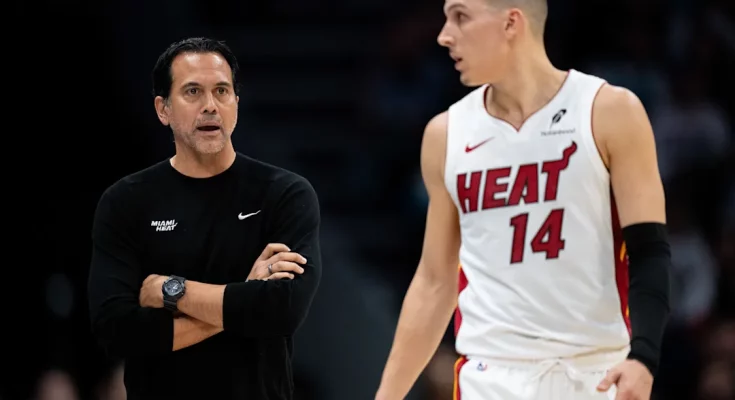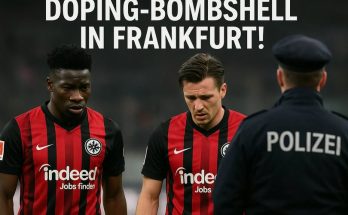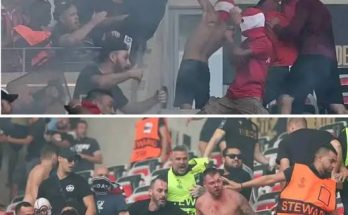The whispers around the league have solidified into a resounding declaration: the New York Knicks have, perhaps unintentionally, plunged the Miami Heat into an unenviable and complicated situation regarding their young star, Tyler Herro. It’s a scenario that speaks volumes about the delicate balance of salary cap management, player valuation, and the relentless pursuit of a championship in the modern NBA. This isn’t just about a single player or a solitary contract; it’s a ripple effect that threatens to define Miami’s immediate future and reshape their long-term aspirations, all thanks to a seemingly unrelated move by their historic rivals.
The catalyst for this unfolding drama can be traced directly to the Knicks’ recent decision to extend Mikal Bridges on a lucrative four-year, $150 million deal. On the surface, it’s a shrewd move for New York, locking up a versatile, two-way wing who has consistently proven his worth. Bridges, while not a bona fide superstar, is a high-level starter, an indispensable piece for a competitive team. His extension averages out to roughly $38 million per year, a figure that, in today’s inflated NBA market, is seen by many as a fair, even slightly discounted, price for his contributions. The perception is that Bridges, in showing loyalty to the Knicks, took a team-friendly deal, creating a benchmark that now reverberates across the league, particularly for players of a similar archetype and production tier.
This is where Tyler Herro enters the nightmare. Herro, coming off what many considered an All-Star caliber season, has consistently developed his game, becoming a primary offensive initiator and a crucial scoring threat for the Heat. His offensive repertoire, particularly his shot creation and improved playmaking, places him in a conversation with players who are commanding top-tier salaries. The unwritten rule of the NBA, however, dictates that a player of Herro’s offensive prowess, especially one who has demonstrated growth year over year, would typically aim for a contract that, at minimum, matches, if not exceeds, comparable talents. The Mikal Bridges extension has effectively set a floor for Herro’s impending contract negotiations.
Consider the optics from Herro’s perspective. He has seen Bridges, a player whose offensive impact, while valuable, isn’t quite at Herro’s level as a pure scorer and creator, secure a deal worth $38 million annually. Herro, who has often carried a significant offensive load for the Heat and has shown a willingness to embrace a larger role, will undoubtedly feel justified in seeking a contract that reflects his perceived value, which insiders suggest could be in the range of $40 million or even higher per year. This isn’t Herro being greedy; it’s simply a reflection of market dynamics and the escalating cost of high-level talent in the NBA.
The problem for the Miami Heat, and why this is truly a “nightmare scenario,” lies in their current roster construction and their long-stated organizational goals. They already have Bam Adebayo on a max contract, and while he is a cornerstone, the Heat are, by most accounts, still in pursuit of that elusive, clear-cut No. 1 option superstar. Their “Heat Culture” identity, built on grit, defense, and collective effort, has propelled them to surprising playoff runs, but the consistent narrative from the front office, and indeed the fanbase, has been the desire to land an undeniable top-tier talent to pair with Adebayo and Jimmy Butler (before his theoretical departure in this future scenario, as the provided information states “Since trading him to the Golden State Warriors, the Heat’s roster has been the youngest in many years.”).
If the Heat were to meet Herro’s likely demands of $40 million-plus per year, it would severely limit their financial flexibility. The collective bargaining agreement has stringent rules regarding salary caps, luxury taxes, and the ability to acquire new talent. Committing such a significant portion of their cap space to Herro, on top of Adebayo’s existing max deal, would make it exceedingly difficult, if not impossible, to sign or trade for that game-changing superstar they covet. They would effectively be locked into a core that, while competitive, might not possess the ultimate ceiling required to consistently contend for championships.
This isn’t an indictment of Herro’s talent or his performance. In a vacuum, he has been an exceptional player for Miami, exceeding expectations and demonstrating consistent improvement. He has blossomed into an All-Star, showcasing a dynamic scoring ability that few players possess. The dilemma isn’t about whether Herro is a good player; it’s about whether he’s a $40+ million player for a team that desperately needs to upgrade its top-end talent. Can a team with two players earning max or near-max deals, neither of whom is universally considered a top-10 or even top-15 player in the league, realistically build a championship contender around them? History suggests it’s an incredibly challenging path, usually requiring an array of highly effective, undervalued role players and exceptional coaching, which the Heat possess, but even then, the margin for error becomes razor-thin.
The Heat front office, renowned for its shrewd dealings and long-term vision, finds itself in an unenviable bind. They value Herro, there’s no doubt about that. He embodies many aspects of their “Heat Culture” – his work ethic, his competitive fire, and his development within their system. However, the organization also operates with a clear-eyed view of championship contention. They understand that sentimentality cannot supersede strategic financial decisions in a league where every dollar matters.
The alternative to paying Herro his market value is equally fraught with peril. Trading him a year before he hits unrestricted free agency, especially if he’s seeking a large extension, could mean getting “pennies on the dollar” in return, as the market for a player due a massive raise can be limited. Losing him for nothing in free agency the following summer would be an unmitigated disaster, a squandered asset for an organization that prides itself on maximizing value. This puts immense pressure on Miami’s decision-makers to find a middle ground, a creative solution that allows them to retain a valuable asset while still maintaining the financial flexibility to pursue their ultimate goal.
The Knicks, by setting the Bridges precedent, have unwittingly complicated this already intricate situation. It’s not a direct rivalry move, but the market ripple effect is undeniable. Every general manager, every agent, and every player’s camp is constantly analyzing comparable contracts, and the Bridges deal has undeniably shifted the landscape for players in Herro’s tier. Now, Miami faces the difficult choice: commit a substantial portion of their future cap to Herro, potentially hindering their ability to land a true superstar, or make the painful decision to move on from a player they’ve invested heavily in, risking a potential backlash from the fanbase and a void in their offensive attack.
The next few months will be crucial for the Miami Heat. The discussions with Herro’s camp will be intense, filled with complex negotiations and strategic posturing. The organization’s long-term vision will clash with the immediate financial implications of a near-max deal for Herro. Can they convince him to take a more team-friendly deal, perhaps closer to the $30-34 million mark that some analysts suggest would be more palatable for the Heat’s grand plan? Or will Herro, armed with the leverage of his recent All-Star campaign and the Bridges precedent, hold firm to his perceived market value?
This “nightmare scenario” is a testament to the intricate dance of NBA roster management, where one team’s seemingly innocuous move can have far-reaching consequences for another. The Knicks, in their pursuit of solidifying their own competitive foundation, have inadvertently pushed the Miami Heat to the precipice of a pivotal decision, one that will undoubtedly shape their trajectory for years to come. The pressure is on Pat Riley and the Heat front office to navigate this treacherous landscape, to find a path that allows them to continue their pursuit of excellence without compromising their financial future or the very core of their “Heat Culture” identity. The basketball world watches with bated breath to see how this complex saga unfolds, and what it ultimately means for both Tyler Herro and the Miami Heat.



